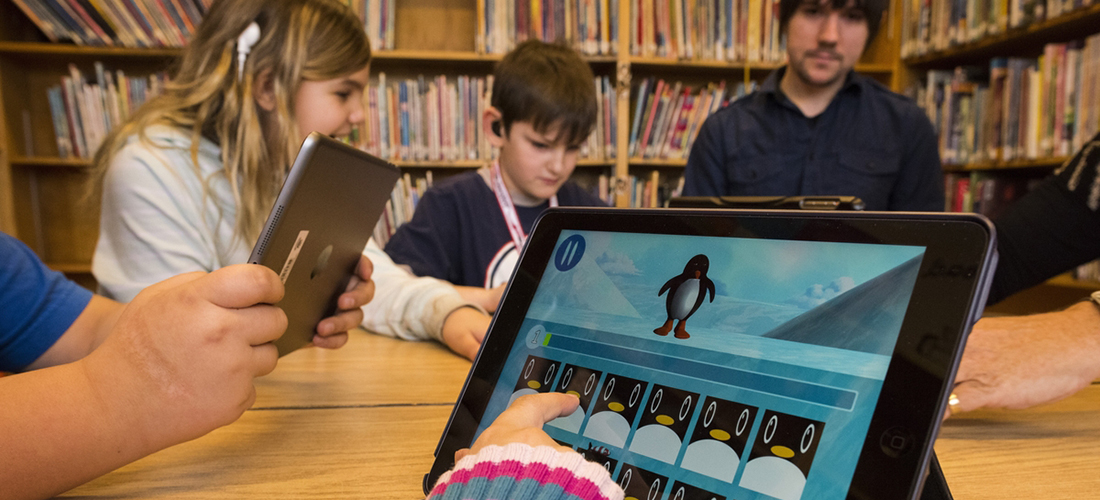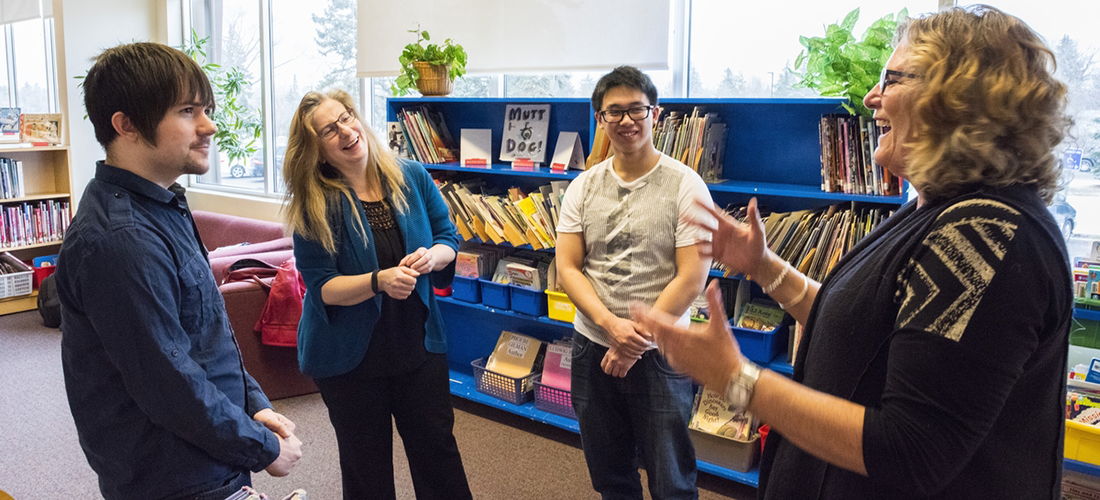
Together, Thomas Baron (pictured) and Eric Lam have developed five educational games with deaf children as co-design partners. The games have a picture-based option to support ASL sign-vocabulary learning and a printed-word option to enhance English print-vocbulary learning.
An undergraduate project turned into innovations that are now improving the lives of deaf signing children. Thomas Baron (BSc '13) and Eric Lam (BSc '14) met in computing science professor Eleni Stroulia's fourth-year software product development course taught in the Department of Computing Science, where students work in teams to build from scratch a piece of software commissioned by a client. Little did they know that their work on an in-class project would have a profound impact on the lives of thousands of students around the world.
Baron tells us what he enjoyed most about CMPUT 401, "Software Process/Product Management," is that it had a purpose beyond memorization and exams. "These type of project-based courses help demonstrate to students why we are learning what we are learning," says Baron. "The fact that you're actually doing something that will be used made me try a lot harder. We spent a lot of time working as a team collaborating and assigning tasks and planning out what we needed to do."
Stroulia explains that she has found in the project-selection process that students are often attracted to projects with a social justice perspective. "It gives students an opportunity to think deeper about what they want to do," she says. "They think about what they want to do, what they want to learn, with whom they want to work, and how they want to continue after the project and class."
Classmates-turned-colleagues Baron and Lam jumped at the opportunity to work with real clients as opposed to case subjects, since it provided both work experience and an unexpected reward. "For me, giving back to the community was a great by-product of the project," says Lam.
Baron echoes that seeing the client's and users' enthusiasm about the project drove the team to work harder, knowing it was making a difference in people's lives.

L to R: Thomas Baron, Eleni Stroulia, Eric Lam, and Lynn McQuarrie.
Their client was Professor Lynn McQuarrie, David Peiko Chair of Deaf Studies in the University of Alberta's Faculty of Education. "We couldn't have anticipated the extent of this project," glows McQuarrie. "The skill level in interpreting what I needed and wanted as a client and what Thomas and Eric and their classmates produced was phenomenal."
The project-connected with Gallaudet University, the world's only university designed for deaf and hard-of-hearing students-was to create a web-based assessment system to house McQuarrie's American Sign Language (ASL) phonological awareness test and was developed with funding from the National Science Foundation's Science of Learning Center on Visual Language and Visual Learning (VL2). The students presented their work to an international team of researchers participating in an assessment symposium at Gallaudet. They impressed the audience, and following 401 course completion, Baron and Lam worked with McQuarrie to expand the capabilities of the system, creating a global multi-test portal for ASL assessments. The system now serves as the backbone of the entire assessment portal for Gallaudet (VL2).
Baron and Lam also began developing learning tools and educational games for deaf children as well as avatar-type signing systems, creating tools that didn't already exist. They plan to release the source code of the avatar signing system to other developers once it has been reviewed by the community, making a difference not only in the lives of the deaf children but also giving back to the software community as a whole.
The sign database at the core of many of the learning games was designed to be generic and usable by third- party developers. is allows fast iteration of ideas based on co-design outcomes and provides baseline architecture for other developers to build upon.
Computing science with a community conscience
McQuarrie explains that though there are many games for hearing children, few exist for deaf signing children. " ere's a bit of a social justice component to it," continues McQuarrie. "Both these young men could go o and do hundreds of things, but they've seen the reaction of the children-signed by the kids as thumbs up, cool, wow-they've seen the need, and they just continue to renew and rebuild."
Software is created in the service of a need, explains Stroulia, who says that she is interested in learning about other people's problems where soft- ware can be applied. Her flagship project is the "Smart Condo," using technology as a means to support people with chronic conditions to live independently longer and to educate health-science students in using technology to provide better care.
"Nobody speaks the language of all the client needs they will have to interact with in order to build soft- ware," says Stroulia. "From an education perspective, this type of project in the 401 class is the best we can do to prepare students. They're practicing their profession inside the university before they even graduate. Our students are working independently and operating as real software companies inside the school. e more practice they have in school, the better o the students will be able to do their jobs."
"You cannot get better than working to improve somebody's life." -Eleni Stroulia
Stroulia relays that not only is there an advantage to the students, there is a priceless bene t to researchers inside the university who can tap in to student expertise for a mutually beneficial partnership that provides a much more cost-effective and efficient way of building software-researchers like McQuarrie, who was amazed by the results.
"I told the students what we needed, and they worked with me and brought their technical computing science language to a level I could understand. The skill level in interpreting what I needed and wanted as a client and what they produced was phenomenal. Innovation can't happen without that bridge."
In a follow-up project in 2015, Baron and Lam completed their first co-design study at the Alberta School for the Deaf in Edmonton and plan for more of these types of interactions in the future. Their co-designers? A group of six- to 10-year-old deaf children who are getting their first peek behind the computing science curtain at an early age. Baron and Lam are thrilled to be working directly with the people who will benefit from their hard work.
"For me, giving back to the community was a great by-product of the project." -Eric Lam
"I want to get in an environment where I am directly interacting with people so that I can better understand their needs," says Baron, who has always had an interest in linguistics. For the co-design study, he and Lam created four different games with differing degrees of difficulty. They all required different skills in terms of memorization, logic, and motor skills. Each child had one or two they preferred. "The big takeaway is that you really have to make the tool adjust to the child."
He acknowledges that the focus is less on pushing the technical envelope and more on creating usable tools. "It shows the impact that good learning tools can have. The fact that this can make a positive influence on people while they are in school focusing on learning really does make us work a little harder."
Echoes Lam, "Seeing the kids play during the co-design study and seeing them have fun made me really happy. Knowing that the learning tools are going to be used and are going to make a difference in these kids' lives gives us more drive. Knowing that kids are enjoying it-that's what keeps me going."
Stroulia agrees that this is an extremely important point. "Computing science is an interesting mathematical discipline," she says. "It is very beautiful and internally elegant. There are some of us who are fascinated by this internal beauty of algorithms, which we will use in a variety of different problems and situations. But there are also many of us who want the gratification of doing something that works for somebody. You cannot get better than working to improve somebody's life. Not many of us will get the chance to do this. Most situations are very far removed from actually making a change in somebody's life. These students were lucky in having that."